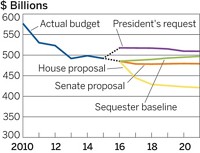Advertisement
Grab your lab coat. Let's get started
Welcome!
Welcome!
Create an account below to get 6 C&EN articles per month, receive newsletters and more - all free.
It seems this is your first time logging in online. Please enter the following information to continue.
As an ACS member you automatically get access to this site. All we need is few more details to create your reading experience.
Not you? Sign in with a different account.
Not you? Sign in with a different account.
ERROR 1
ERROR 1
ERROR 2
ERROR 2
ERROR 2
ERROR 2
ERROR 2
Password and Confirm password must match.
If you have an ACS member number, please enter it here so we can link this account to your membership. (optional)
ERROR 2
ACS values your privacy. By submitting your information, you are gaining access to C&EN and subscribing to our weekly newsletter. We use the information you provide to make your reading experience better, and we will never sell your data to third party members.
Policy
Budget Deal Promises Relief
Government: Science agencies may get reprieve from across-the-board cuts
by Andrea Widener
December 13, 2013
| A version of this story appeared in
Volume 91, Issue 50
After years of near-constant wrangling, congressional leaders this week reached a bipartisan budget deal that would avert another federal fiscal crisis for two years.

If passed by both the Senate and House of Representatives, the bill will prevent a government shutdown on Jan. 15, 2014, when the current temporary budget deal expires. Even more important for R&D funding, the deal will provide temporary relief from the across-the-board budget cuts, called sequestration, that took effect in March and are set to continue for a decade.
The deal “is an important first step toward slowing the damage the nation’s biomedical research enterprise has been enduring since sequester cuts began drastically cutting our national investment in basic science research,” says Benjamin W. Corb, spokesman for the American Society for Biochemistry & Molecular Biology.
The agreement from budget committee leaders Rep. Paul D. Ryan (R-Wis.) and Sen. Patty Murray (D-Wash.) sets discretionary spending levels—which include most federal R&D—at $1.012 trillion for fiscal 2014, which began on Oct. 1, and $1.014 trillion for fiscal 2015. That restores about half of the sequester’s cuts in 2014 and about 25% in 2015, according to an analysis by the American Association for the Advancement of Science.But some Democrats are threatening to vote against the bill because it does not extend benefits for the long-term unemployed.
The details of how this will trickle down to science agencies still need to be worked out by congressional committees. Federal agencies, including those that fund much of chemistry-related research,do not comment on pending legislation. But observers say that science is likely to reap the benefits by returning to presequester funding levels.
Many scientists appreciate the temporary relief, but they are disappointed that the agreement doesn’t address the larger budget issues facing the country. For example, the plan takes no action on tax and entitlement reform, and it spares agencies from sequestration cuts for only two years, even though the cuts by law can continue for 10 years.
Research!America President Mary E. Woolley says, “Until policymakers tackle those issues head-on, we will continue to fund research at levels far below what’s necessary to maintain our competitive edge.”



Join the conversation
Contact the reporter
Submit a Letter to the Editor for publication
Engage with us on Twitter